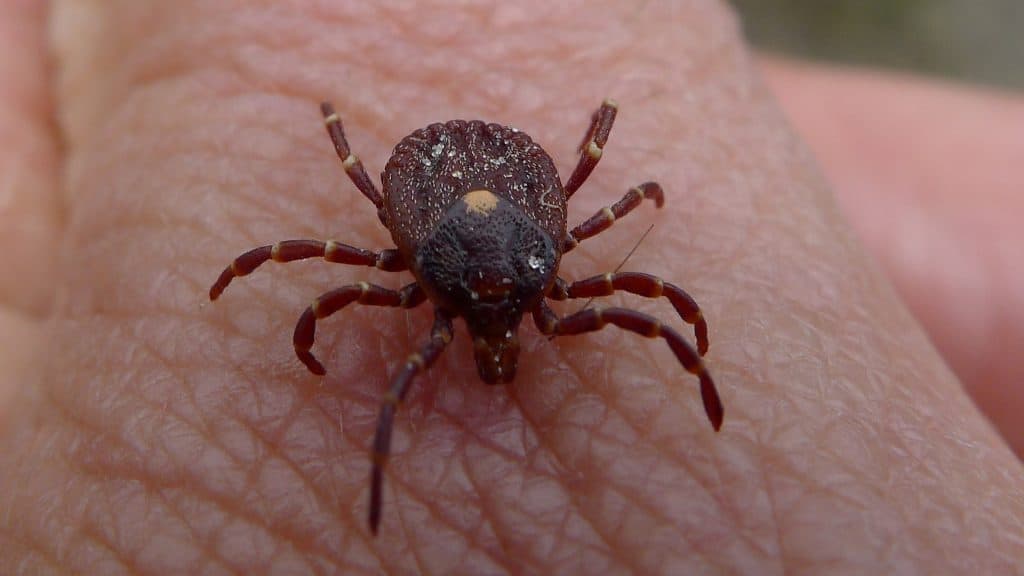
Written by Stephen Ondich
When visitors travel to Acadia National Park, they’re often reminded to leave nothing but footprints and take nothing but memories. An unfortunate few hikers unwittingly take home deer ticks, the conduit for Lyme Disease. If untreated, Lyme Disease poses a serious danger to the victim.

What is Lyme Disease?
Lyme disease is caused by the transfer of bacteria from Deer ticks to humans. It is an inflammatory disease that causes headaches, dizziness, rashes, joint pain, fevers, neurological problems and fatigue. If left untreated, it can lead to heart problems, as well.
I have a personal connection to this illness. My brother, Eric recently passed away at the age of 54. Although the direct cause of his death was not Lyme Disease, doctors suspect that complications from a bout with Lyme disease decades earlier contributed to his declining health.
Lyme disease can have long standing effects on your well being. Singer Avril Lavigne was reportedly bed-ridden for five months following her exposure to Lyme Disease. Bacteria-borne diseases have a way of hanging around in a body’s system longer than you’d think. Instead of just Lyme, people are now being diagnosed with Chronic Lyme Disease or Post Lyme Disease. These new terms reflect the medical community’s understanding and acknowledgment of the resilience of Lyme. It is estimated that 10-20% of those infected fall in the category of long term illness.
Although it is a cliche, an ounce of prevention is really worth a pound of cure.
What is the Risk of Contracting Lyme Disease?
A recent study by 24/7 Wall Street identified Maine as the #1 state in Lyme Disease cases. In other words, you’re more likely to catch Lyme in Maine, than in any other state.
It’s a ranking that Maine would gladly hand off to another state. However, if we unpack this proclamation, it’s not quite as ominous as it sounds.
Due to the dense wooded nature of Maine, conditions are conducive to insects like Deer Ticks which spread the disease. Removing the forests and foliage would alleviate the tick and Lyme issue but that’s throwing the baby out with the bathwater. People love Acadia National Park for its lush beauty. Does enjoying nature put us at risk? Sometimes it does.
Lyme Statistics
In 2016, Maine had 90 cases of Lyme Disease for every 100,000 people. That translates to a .09% affliction rate within Maine. While that probability is most certainly higher than your chances of being struck by lightning, the majority of those affected by Lyme Disease are people who live and work in rural wooded areas on a daily basis. Although the statistics don’t break it down for us, visitors to Maine tend to have limited exposure to heavily wooded areas.
Tick Season
For the sake of Lyme prevention, we should focus on tick activity. Lyme diagnoses rise in direct proportion tick populations.
In 2018, Lyme cases dropped sharply from 2017. The evidence suggests that the unusually dry summer resulted in lower tick reproduction. Accordingly, less ticks meant less tick bites and less Lyme. Also, a more pleasant outdoor experience, generally speaking.
According to the Maine Medical Research Center Institute, 66% of Lyme infections occur between June and August. I don’t suppose that’s when you are planning to visit Acadia National Park, is it?

Preventing the Tick Bites that Lead to Lyme
Here are some easy things you can do to reduce your exposure to ticks inside Acadia.
- Wear light colored clothes. The ticks don’t care about your fashion sense. However, if one decides to hitch a ride on your pants, it will be easier to see them against a white backdrop than a black one.
- Use a tick repellent that contains Deet.
- Watch where you walk. If you have the option of staying on a clear path rather than forging through dense brush, do it. Ticks love bushy areas. No need to make yourself an easy target.
- Carefully inspect yourself before leaving Acadia National Park. check yourself once again after removing your clothes at home. Ticks gravitate toward warm areas. I’ll just leave it at that. Bites from young smaller ticks are dangerous because they aren’t as noticeable as a larger tick’s bite. Just because nothing itches, don’t skip the self inspection.
- After removing your hiking clothes, put them in dryer for 10 minutes to kill any ticks clinging to your outer ware.
- Cover up as much skin as possible with clothing. Ticks can’t bite what they can’t reach.There is a big difference between seeing a tick on your jeans and seeing a tick sunken into the back of your leg.
For a more detailed step-by-step tick self-inspection guide, check out ticksinmaine.com.
Protect your Pets from Ticks
Don’t forget to take precautions with your animal companions, as well. Acadia is very dog friendly by National Park standards. So is the rest of Maine, for that matter. My dog Rose is low to the ground, loves to roll in the brush and has a lush coat of fur.

If your dog is anything like Rose, she will ignore all of my suggestions above. Thus, you need to take the lead. Make sure she has good tick repellent applied and inspect her very carefully upon leaving the park
Finding Ticks
Small ticks often resemble moles on your skin. If you see any unfamiliar moles, check them carefully. Pay special attention to the area behind your ears, between joints and anywhere that hair grows.
For identification purposes, enlarged pictures of ticks can be found here.

Tick Removal
According to the Centers for Disease Control, this is the correct way to remove ticks from a human or pet.
- Use tweezers to grab the tick as close as possible to its point of skin contact
- Pull the tick straight out with steady pressure. If parts of the tick remain embedded, remove them individually as best as you can.
- Using alcohol, soap & water, thoroughly wash everything that came into contact with the tick.
- Flush the tick down the toilet. Resist the temptation to exact revenge by crushing the tick.
A Tick Bit Me, Now What?
If you are bitten by a tick, don’t panic. Although ticks can spread Lyme Disease, not every tick does. Also, ticks take approximately a day and a half to spread the infection. A simple antibiotic is typically all that’s needed to provide peace of mind at this stage. According to Johns Hopkins Medicine, keep a close eye on the bite area for the next 14 days. If you notice the bite area forming into an expanding red rash, see a doctor immediately. Always seek medical treatment if you suspect you’ve encountered a Deer Tick. Better safe than sorry.
How to Tell Deer Ticks from Other Ticks
Deer Ticks are the ticks most responsible for spreading Lyme Disease. If you find a tick latched onto your body or that of your pet, you should try to determine if it is a Deer Tick or not. No matter the sub-specie, you’ll want to follow the same removal procedures. However, if you suspect the culprit is a Deer Tick, you will need to take extra precautions.
Here is a guide that explains several methods of distinguishing Deer Ticks from Dog Ticks and other types of ticks.
However, if you are in or around Acadia National Park when you spot the tick, I would attempt to keep it to show to a National Park Service worker. They are in the trenches year round dealing with native park insects. Their insight could save you a lot of stress, time and worry.
Are Acadia Visitors at Risk of Lyme Disease?
Short answer is… sort of.
You need to be aware of the risks and take safeguards to minimize them. That being said, avoiding Acadia because of Lyme Disease is like staying away from the Bahamas to steer clear of sharks. A more reasonable solution is to use caution and common sense while enjoying the majesty of Acadia. Wearing Deet-based repellant, selecting light colored clothing and performing self inspections are easy ways to protect you from Lyme exposure. Have fun and enjoy the park!



Molly Ondich
11 Mar 2019This is great information! Thank you so much. I’m planning a trip to acacia national park and was wondering about the risks. I’m glad to have this knowledge in my back pocket. I look forward to future posts.
Stephen
11 Mar 2019Thanks Molly! Have a great time at Acadia and be safe this Summer!
Pingback: Are There Moose in Acadia National Park? - Maine Terrain
Heidi
13 Mar 2019I was planning on bringing our dog to Acadia this summer and was wondering if he would require the same protection as us humans need against ticks. Thanks for the info and I am sorry to hear about your brother.
Stephen
13 Mar 2019Thank you for reading. It is a good idea to check your dog carefully for fleas and ticks, just as you would yourself. If your dog brings home ticks that carry Lyme, you are literally “not out of the woods.”